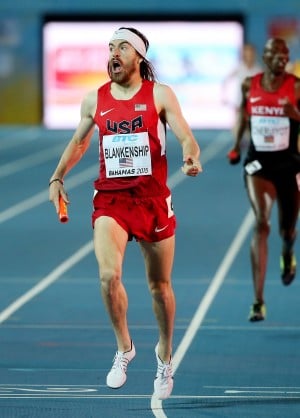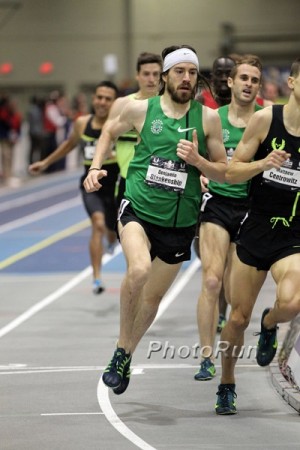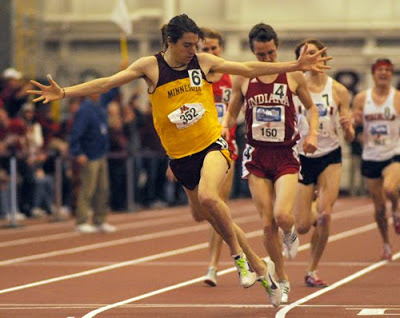From Excavation Grunt To The U.S.’s Fastest Man At 1,500: Ben Blankenship Discusses His Journey And His Breakthrough 2015 Season
By Jonathan Gault
May 20, 2015
Three years ago, Ben Blankenship was injured and working in excavation with a friend in Colorado. The NCAA runner-up in the 3000 at Minnesota the year before during which he ran 3:54 for the mile and 7:49 for 3000 wasn’t getting ready for the Olympics or Olympic Trials, rather he was mulling giving up on the sport if he couldn’t solve his injury woes. But after moving to Washington, D.C. that fall, Blankenship started working out again and was fit enough that Oregon Track Club head coach Mark Rowland asked him to take a chance and move out to Eugene. The past three years haven’t been all smooth sailing, but now that Blankenship has been able to stay healthy and log consistent mileage, he’s torn up the track in 2015.
 Ben Blankenship at World Relays © Getty Images for IAAF *World Relays Photo Gallery
Ben Blankenship at World Relays © Getty Images for IAAF *World Relays Photo Gallery
Blankenship began 2015 by beating Galen Rupp in the 2-mile in his season opener at the Armory Track Invitational. He knocked out an IAAF qualifier with his 3:53.13 mile in Boston the next weekend and by the end of the indoor season, he had added a 3:35.28 1500 and a pair of runner-up finishes at USA Indoors.
Blankenship has kept that momentum rolling outdoors, running a 3:51.24 anchor leg on the U.S.’s world-record-setting DMR at the World Relays and taking fourth in the 1500 (3:35.48) at Sunday’s Shanghai Diamond League event, the best DL finish by an American man in a 1500/mile since Leo Manzano in July 2013. Up next for Blankenship is a mile at the Pre Classic next weekend; as of now, he’s running the International Mile but still holding out hope to get bumped into the prestigious Bowerman Mile. After that, Blankenship doesn’t have any races penciled in on his schedule prior to USAs but may jump in one or two if the right opportunity presents itself.
I caught up with Blankenship on the phone Wednesday morning as we discussed his journey to Eugene, the key to his 2015 success and hitchhiking.
Jonathan Gault: How were you feeling on the start line in Shanghai? It was a long way from home for your first big Diamond League race.
Ben Blankenship: I was excited and just excited to have the opportunity to get into a race and mix it up. I heard the pacing, them going out so fast. I was actually quite excited about it but I was a little bit hesitant just knowing a lot of times when they do ask for that pace a lot of people don’t end up going with it and obviously we didn’t end up going with it. Just kind of going through it, I thought it’s about being competitive now. I guess that was my total goal no matter what was going to work out.
What pace did they ask for?
I think they wanted sub-3:30 pace. So a 52 first [lap] and coming through in 1:54 or something [for 800].
How do you feel about your performance?
Overall I’m somewhat satisfied. I’m satisfied in the fact that I competed and that I ran a competitive race but I’m a little frustrated in that I made the same mistakes I made in Birmingham and indoors, where I let it get away from me a little too much and allowed those guys to step back up.
I think it’s a learning curve and it’s about figuring out how these races are won and lost. And obviously if you don’t have an open lane to run, it’s hard to win. So in saying that, I think I’m somewhat satisfied with it.
You’ve done a lot of cool stuff this year on the track. What has been the highlight for you?
Probably World Relays. That was a fun event, just being part of the U.S. team and everybody coming together and making something pretty grand happen. I think that’s probably the highlight of my year so far.
You were at Mississippi State for a year and then transferred to Minnesota. Mississippi State isn’t regarded as a distance powerhouse. I’m wondering why did you choose to go there out of high school and why didn’t it work out?
The honest answer is academic. I wasn’t the best scholar in high school. It just wasn’t one of my priorities I guess growing up and I never really took it that seriously. Honestly, I didn’t think I was going to continue running into college or at least go to college just to go. I kind of wanted just to run. Maybe I kind of f’ed some things up in high school and it put me into a poor situation coming into college.
So that was one of the reasons I made the decision to go to Mississippi State. The other reason was that it was an opportunity for me to go to college and not walk out with any debt. It was kind of a combination of things. They gave me an opportunity to continue running. My first year wasn’t so great but it got me into the door of college and got me back into a higher caliber of athletics.
Why did you make the decision to transfer?
God, I haven’t thought about this in years. I guess the decision was made because I had a lot of friends that ended up going to Minnesota like Hassan Mead and a couple other guys — Mike Torchia, that I knew in high school and Ben Puhl and Justin Grunewald. And I knew quite a bit of those guys, Rick Furseth being a big guy that I knew in high school having gone to Stillwater High School. Those guys stayed in Minnesota and it kind of made me want to go back. I saw those guys have success. Steve Plasencia recruited me [in high school] and we just couldn’t go any further. [After my freshman year at Mississippi State], I thought maybe there’s an opportunity for me to go to the University of Minnesota, run under Steve Plasencia and get back and hang out with my friends again.
How long have you been with Oregon Track Club?
I joined OTC in 2013, basically. 2012, somewhere in there. The late fall of 2012, basically the beginning of 2013.
I was looking at your All-Athletics profile. You don’t have any results for the year of 2012. Can you tell me what happened that year?
I came out of college in 2011 and I had some injuries. I just couldn’t get back on it. It was kind of a struggle in terms of trying to get something going. I just never could get my legs to do anything. When you’re not training well there’s no sense of really racing. I tried to make it a building year. I got through the spring and kind of was just putting haphazard week [after] haphazard week together. And finally by September of that year I was running more consistently.
It was a sad year to miss [with] the 2012 [Olympic] Trials. It was a tough year coming off a fairly good 2011 and leaving college it was just a poor transition for me.
What injuries were you dealing with?
I had kind of numerous injuries. One developed after another. I came out of college with this injury called femoral anteversion impingement. It’s a fairly common injury and a lot of people actually have it but people who do have it probably aren’t competitive distance runners. They’re probably football players or some kind of impact sport. It was unlucky I got it. I had a really good surgeon who helped me through the surgery and it just took me a really long time to recover and put all the pieces back together.
Was there ever a time during that year, 2012, that you thought about giving up the sport and moving onto something different?
Yeah, for sure. Anytime you’re dealing with an injury that takes so long to recover from, I think there’s always that thought of you’re not going to do it. I made decisions that year to do other things.
I moved to Washington, D.C. for a little while. I was just trying to get back into running a little bit. I was also pursuing other options. I worked in Colorado for a good while that spring, just trying to get my foot in some different doors and put some money in my pocket.
What job were you working in Colorado?
I was doing some excavation work with a friend of mine up in Colorado. Mainly just a grunt, a labor grunt. But it was good, it was a good time. It kind of put things in perspective. It allowed me not to worry about running so much and allowed that to just come when it wanted to.
Were you healthy by the time you joined OTC that fall?
I moved to Washington, D.C. that summer/fall area. It was kind of a transition. I knew Sean Graham from having graduated from Stillwater Area High School and him being an alma mater from there. He was coaching at American University at the that point. Through the grapevine, I got linked up with those guys. I was jumping in and out of a weekly workout here or there. That motivated me to get back into it and trying to get my legs back under me.
At that point, I had had several conversation in 2011 with Mark Rowland and Mark Rinker, who was the assistant coach out here [at OTC]. It just never materialized. I didn’t want to leave school yet, I had one more class to finish. I thought I’d probably run at Minnesota while I finished up and then I’d make the next transition so that I did graduate school…I just never took him up on the offer until later that year. It was a deal where I talked to Coach [Rowland], and eventually he took the chance and said, “Why don’t you come out, things are going okay for you.”
What has been the biggest difference between this season and the past few years? You had a few strong performances in 2013 and 2014 but I think it’s safe to say you’re on a different level this year.
I think it’s just about consistency. Obviously 2013 I had absolutely really no background in my legs. I think it’s a transition always when you’re moving to a new coach. You’re trying to figure out his quirks, he’s trying to figure out your quirks and what’s working for you and what’s going to be successful. It’s kind of a time where it’s trial and error.
I had some success in 2013 a little bit here and there (Editor’s note: he ran 3:35 for 1500, 3:56 for the mile and 7:47 for 3000) and it was a feeling-out process about what’s the dynamic between coach and athlete.
2014, I thought I was in pretty good shape, I ran an all-right indoor season in the 3k up at altitude (5th at USA Indoors). Just coming off that, I thought ‘All right, maybe I’ll give it a go here’ and finally when I got everything going, I ended up stupidly breaking my toe and it just was at the worst time possible. It was four days before the Prefontaine meet. I only raced [two times] that outdoor season. Before I knew it the season was over and we were into the fall and I was back at altitude training.
Did you think at the start of the year what you’ve accomplished this season was really possible — you were second twice at USA Indoors, spitting distance to Silas Kiplagat in Shanghai — or have you surprised yourself with your success?
My goal this year was just — if I was going to do this to this level and to this degree, I have to get back to being competitive in all the races I run. No matter if it’s the Turkey Trot in San Jose or the Shanghai Diamond League, it’s about being competitive and running races to win.
I think in 2013 and 2014 I forgot about that. I thought more about trying to run fast. Just as running fast is important, being competitive in the races you run is even more important. Coming into this season, I just thought, ‘Man, if I’m not going to be competitive on a U.S. scale or even on an international scale, what the hell am I doing?’
It was two years of poor racing and poor training. I was like, ‘Man, I’m kind of sick of this. What am I doing out here anymore?’ So I just thought if I can just start running competitively, get my nose into all the races that I run, stay focused on that, then maybe I’ll just keep doing it.
What is your weekly mileage at these days?
It varies a little bit. Obviously traveling and trips like Shanghai throw it off a little bit. Making the transition to being at altitude to being solely on just a training regimen to now racing every other week, I couldn’t truthfully tell you. I would probably say around 80 miles a week to 90 miles a week [down] to 60 miles a week. I kind of vary a little bit and just try to run when I can and run when I feel good and make sure my workouts are the most important thing I’m doing every week, plus doing all the weights and everything.
Do you have a favorite workout?
I enjoy training more than I probably enjoy racing. I like really big, long intensity workouts just because I like being out there for a long time and that’s the stuff that gives me confidence going into races.
Who are your main workout partners?
Ciaran O’Lionaird is my main workout partner. Him and I were up in Flagstaff together all the way through the winter season. Obviously we kind of varied a little bit when we came to indoors but then we came back to altitude together [before outdoors]. It was mainly just him and I.
What do you like to do in Eugene in your free time?
I have two dogs and a beautiful girlfriend so when I’m home, just hanging out with them. I really try to spend as much time at home as I can. I own a bunch of cars and it’s always a constant fixing of things while I’m back home. As you can imagine, being gone every four or five months of the year, every lapse of time, things need to get [fixed].
I heard a LetsRun messageboard rumor that you once hitchhiked across the USA. True or false?
Oh, I’d love to.
So you haven’t done it?
I hitchhiked around when I was a kid. Prior to going to college, I took some time to explore my hippie side, I guess. I did a little hitchhiking here and there.
What’s your best hitchhiking story?
Oh, I have no idea. It was a lot more soul-searching and just finding myself at that point.
Biggest thing you’ve learned this year?
Just you gotta be tough. Every time you get out there it’s always hard. There are no real free rides in this sport. Maybe some races feel better than others but they’re all pretty tough and they’re all pretty hard. Physically, you’ve just gotta be prepared to get your ass kicked every time you get out there.
Editor’s note: Want to know more about Ben Blankenship? Read and talk about him on the messageboard: MB: Ben Blankenship: What’s his story?


